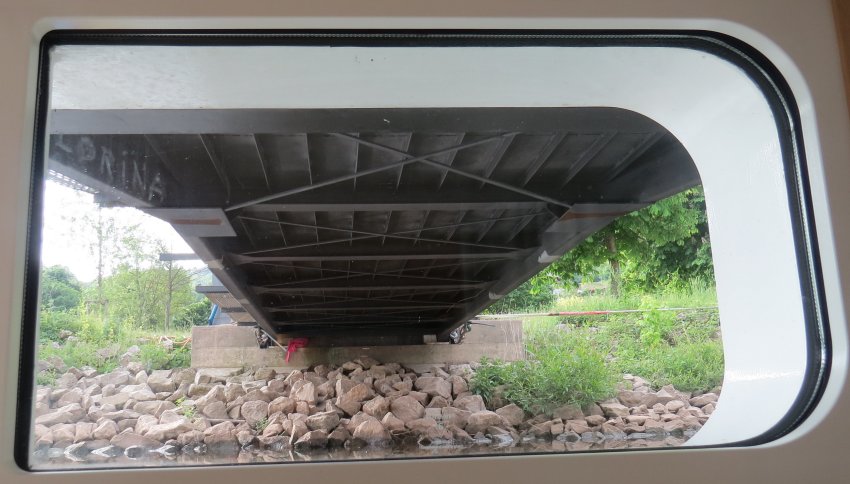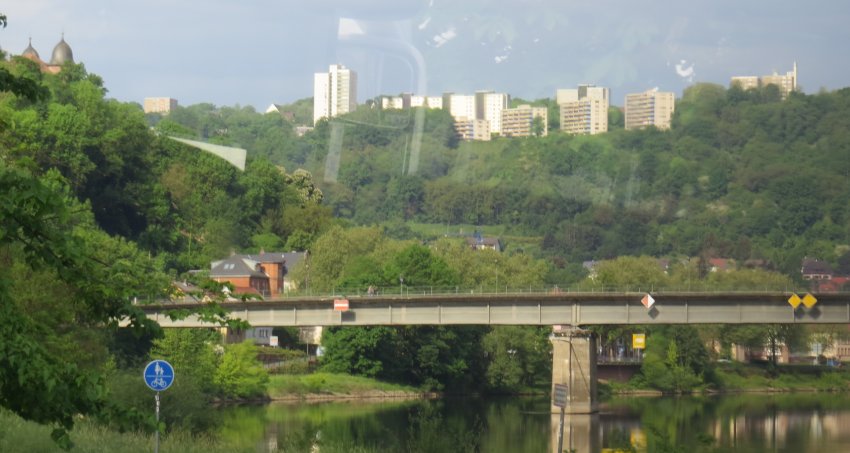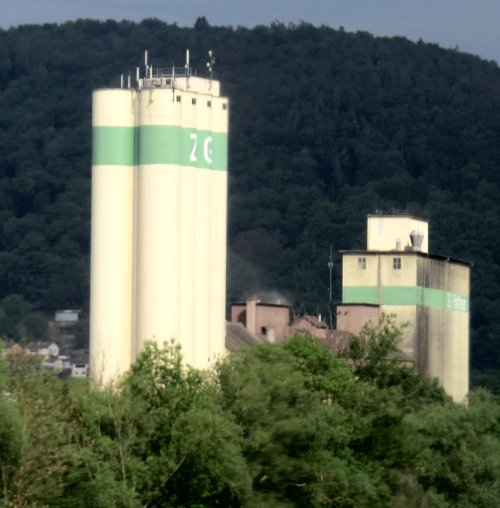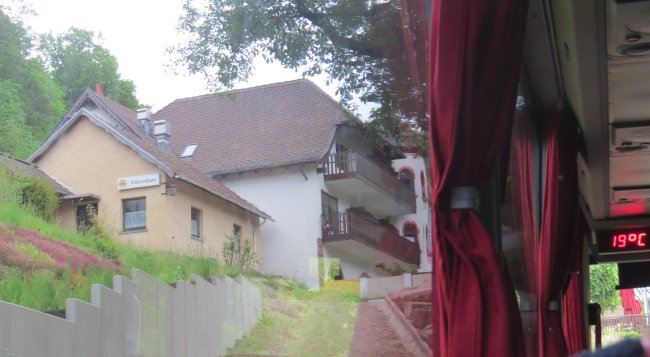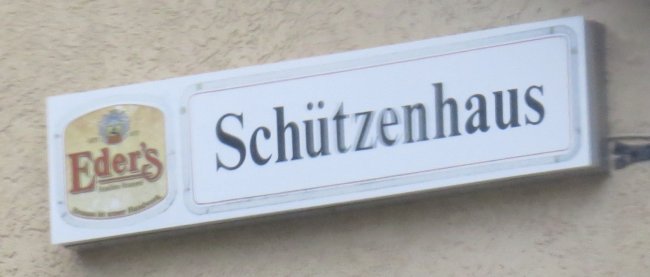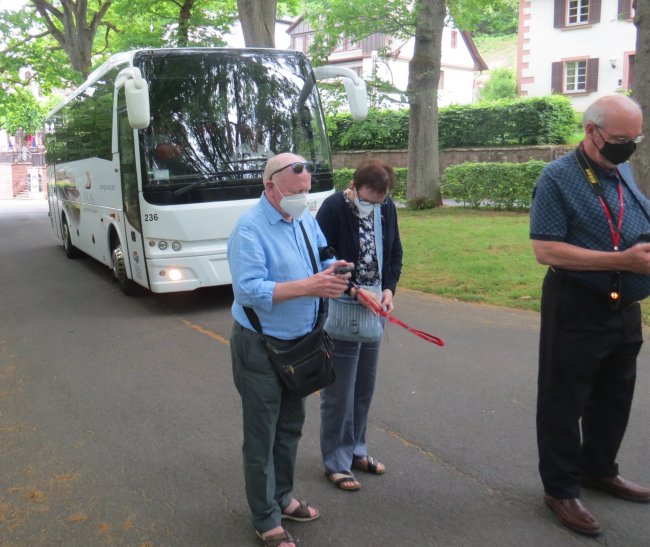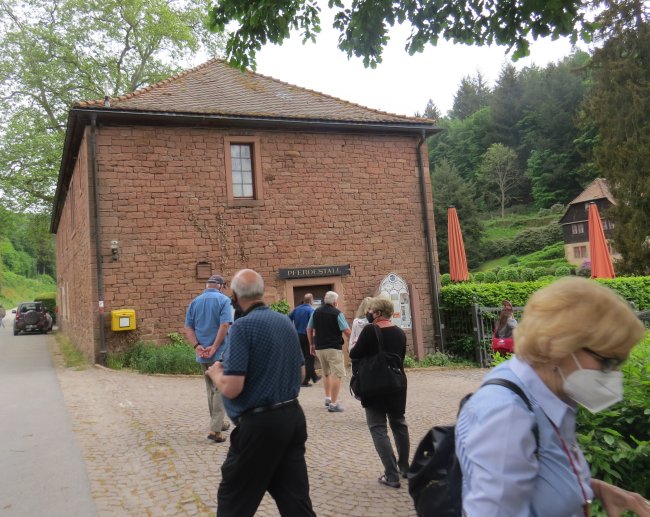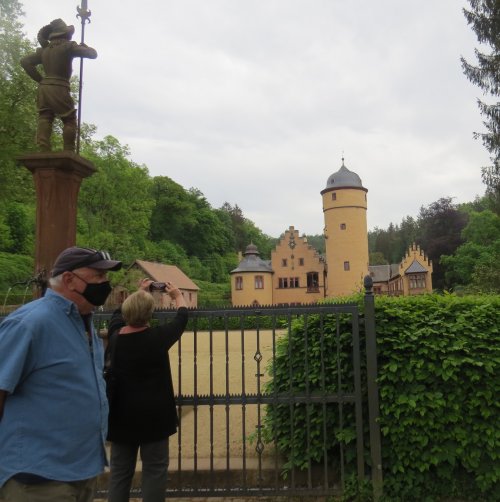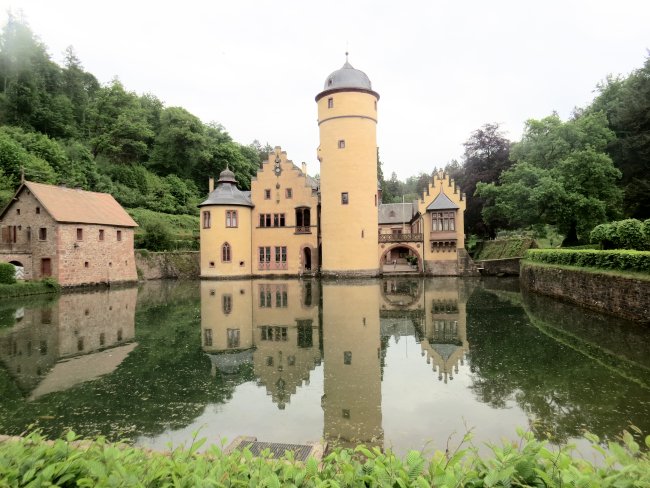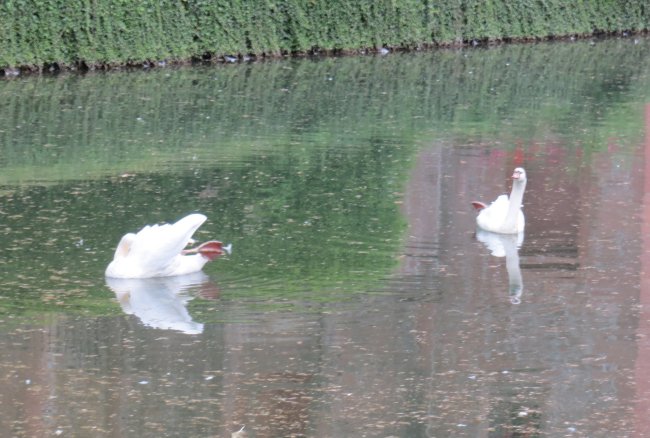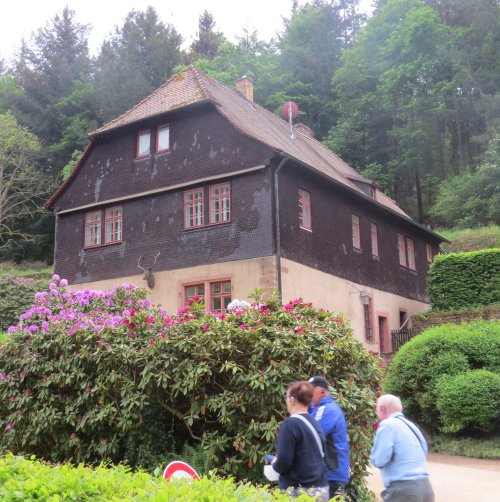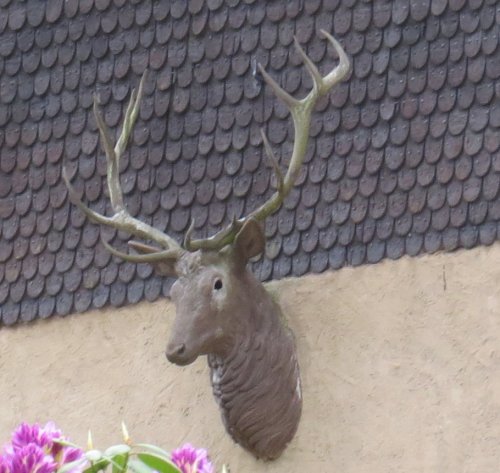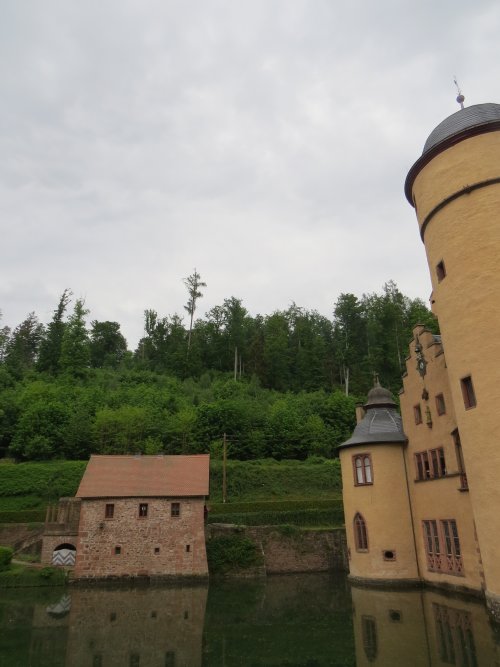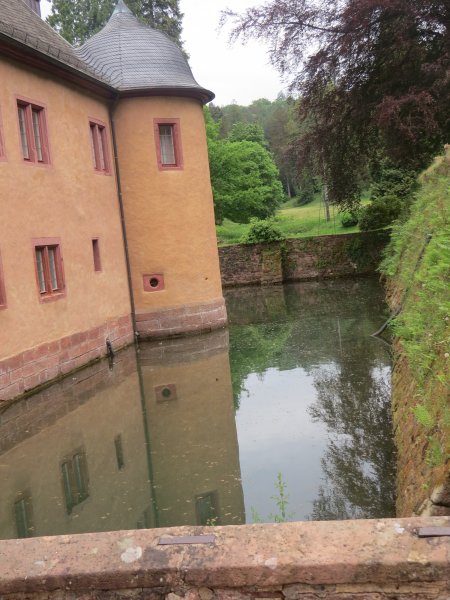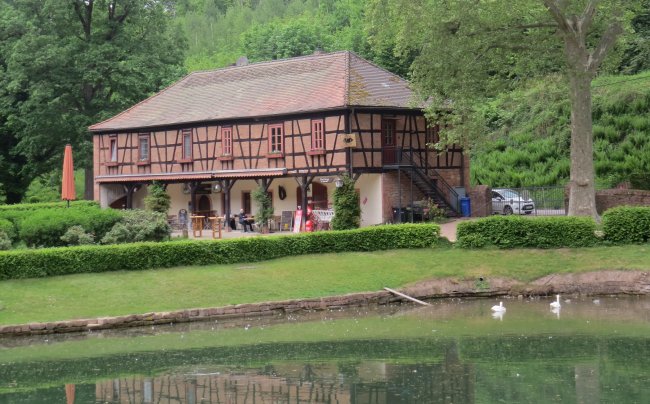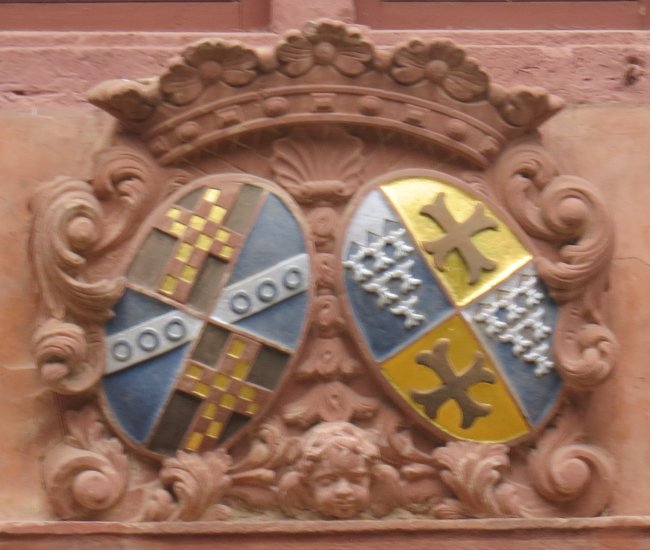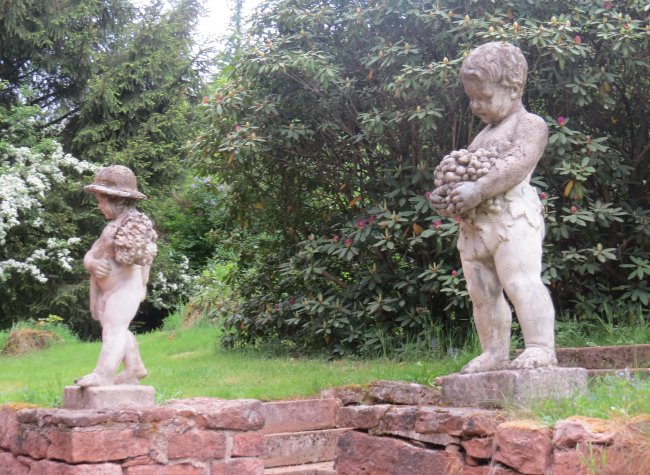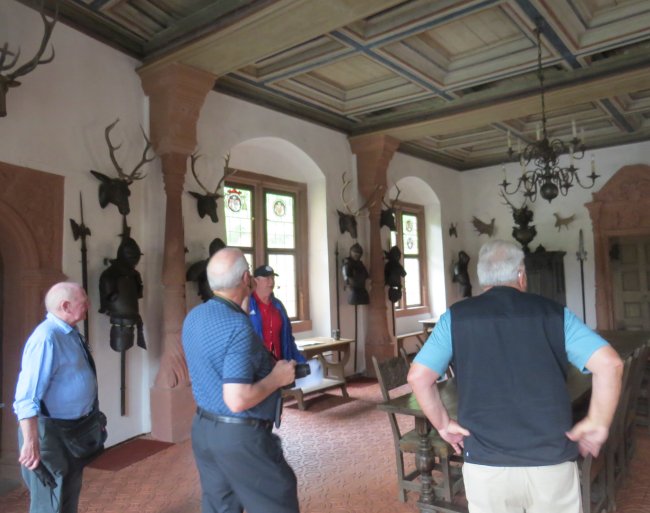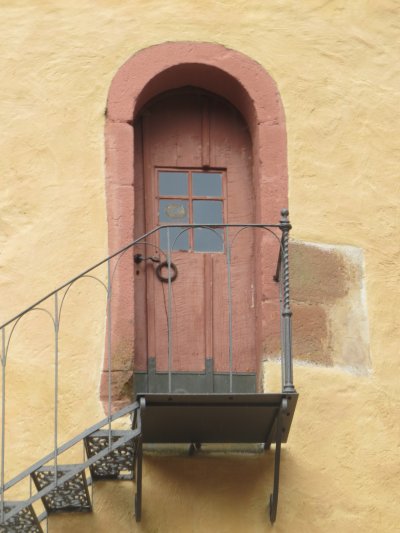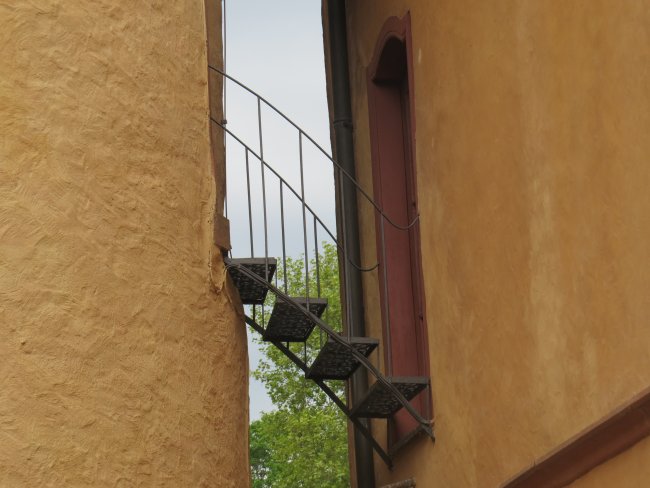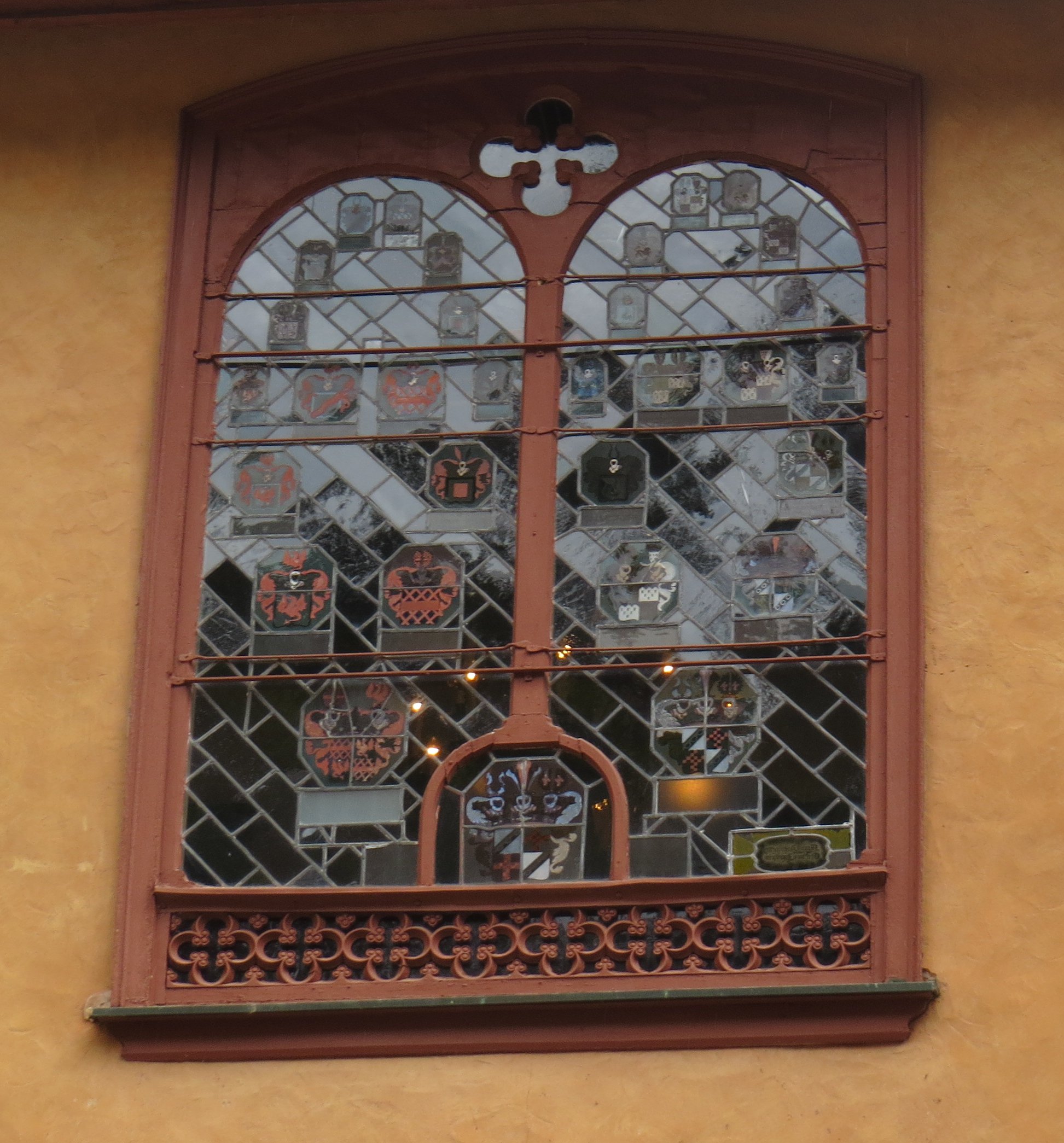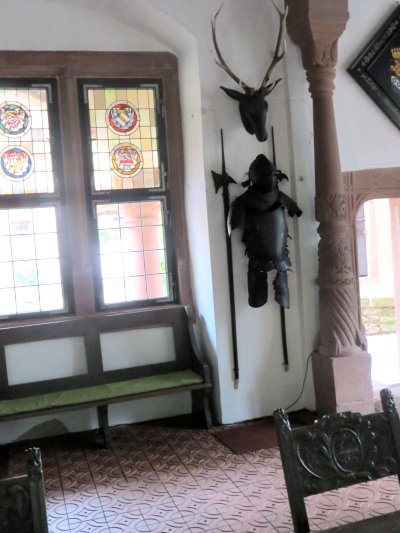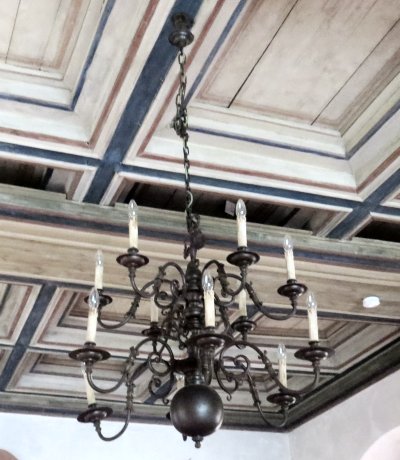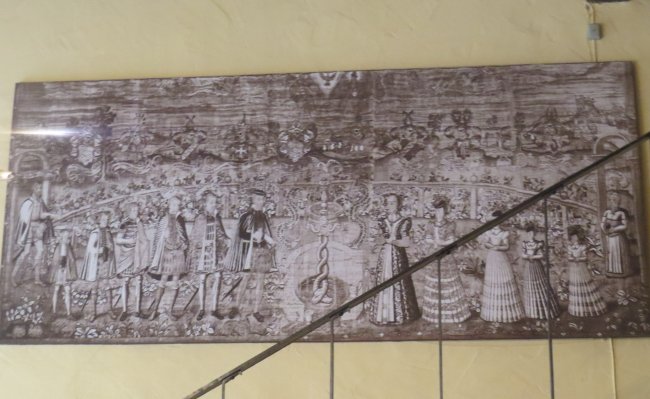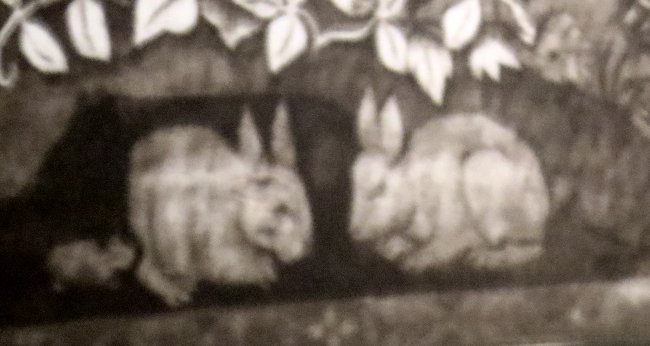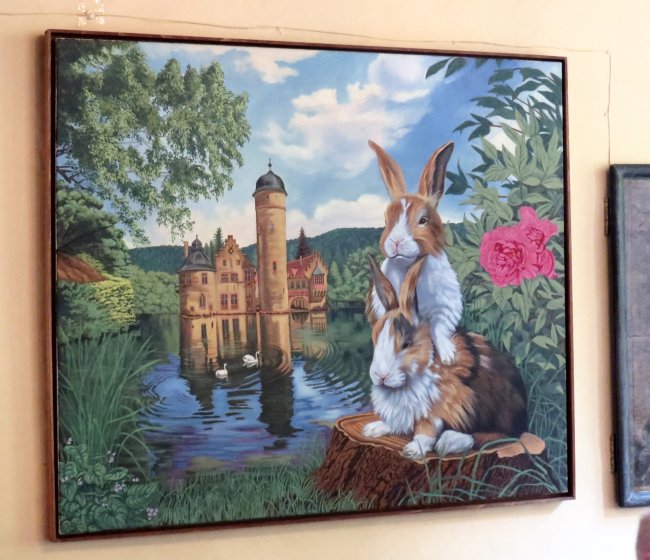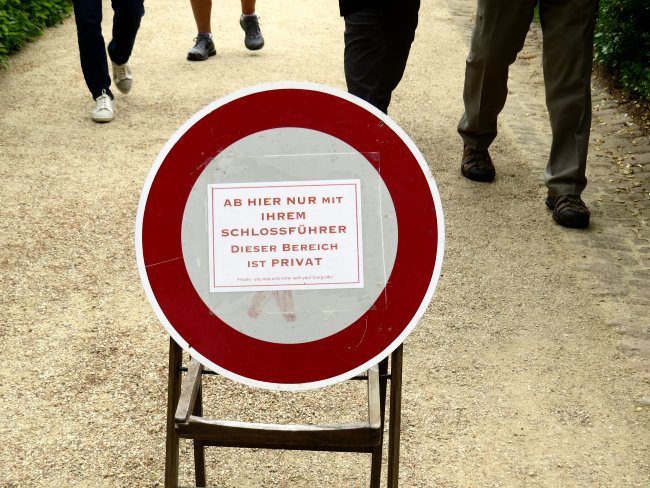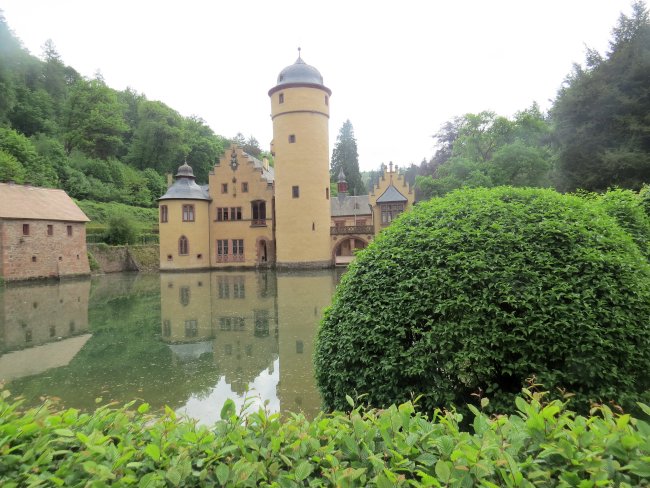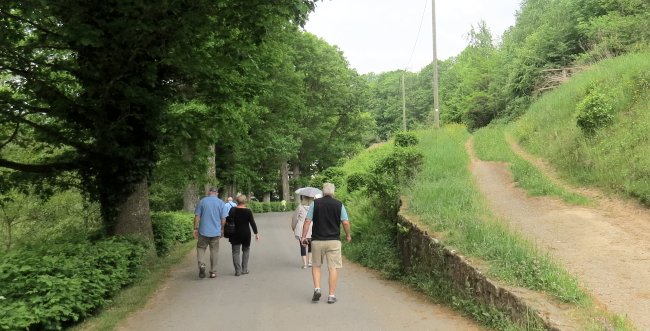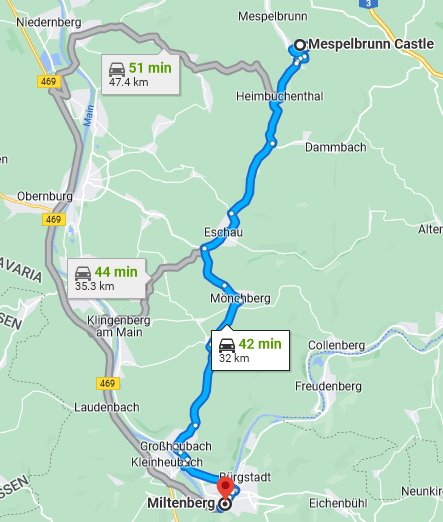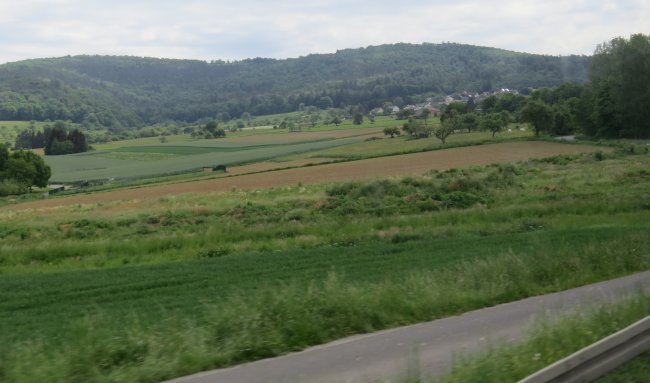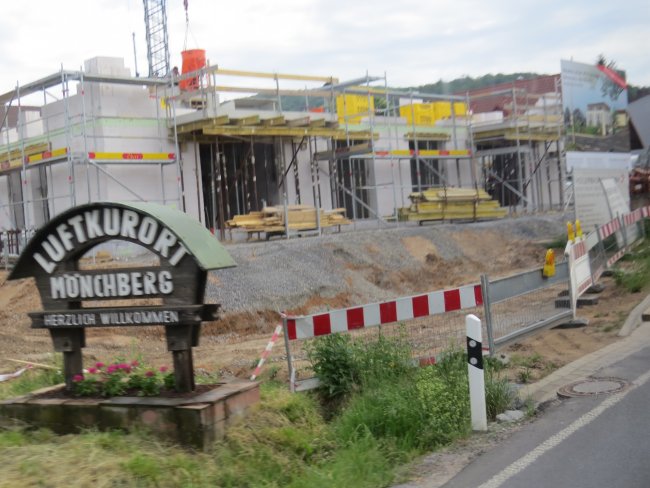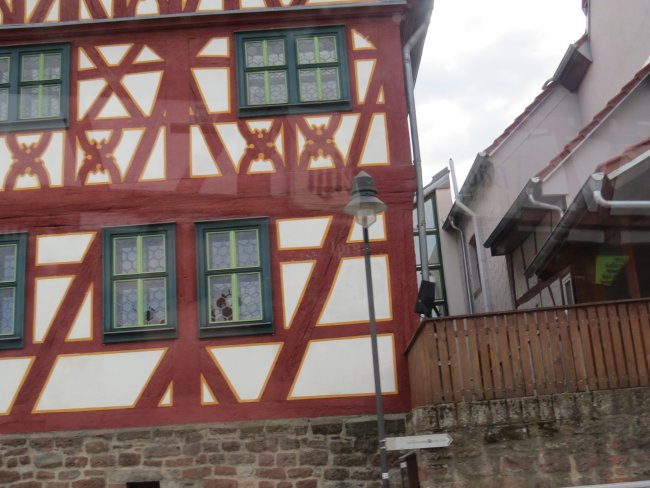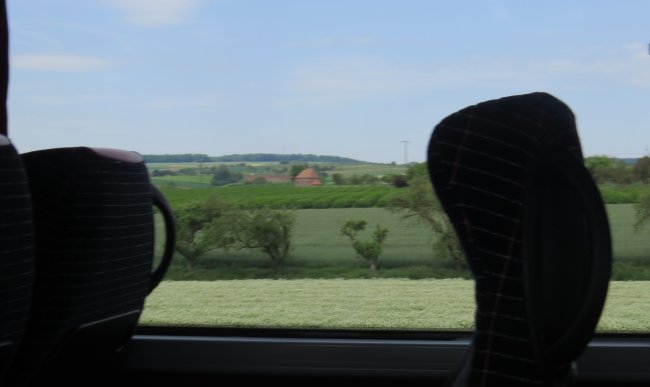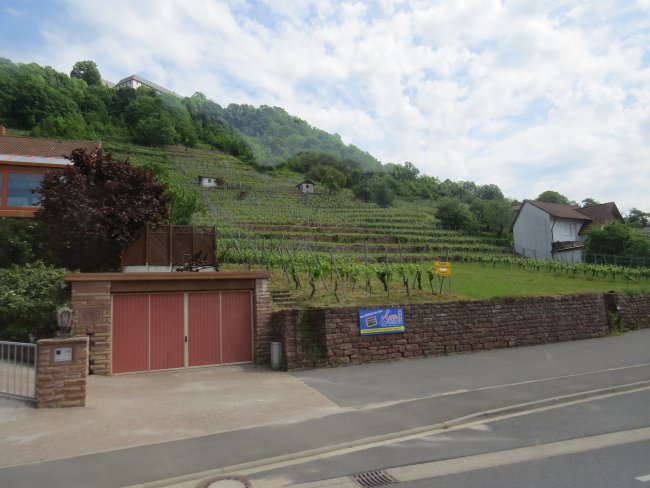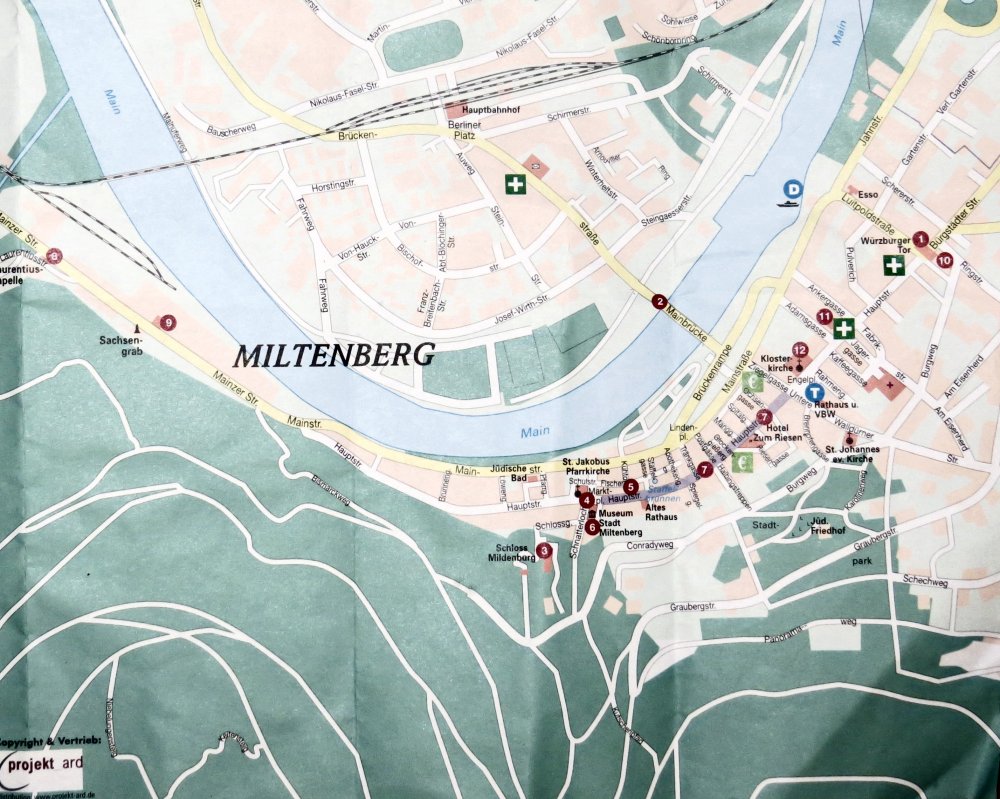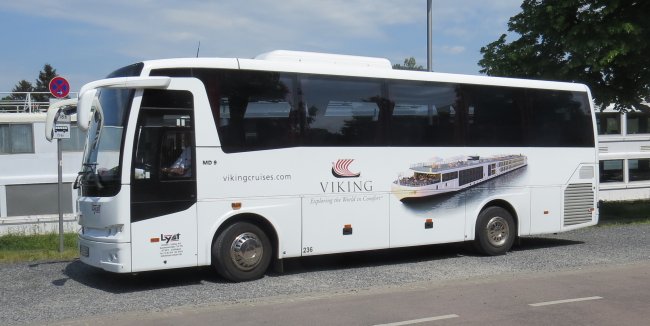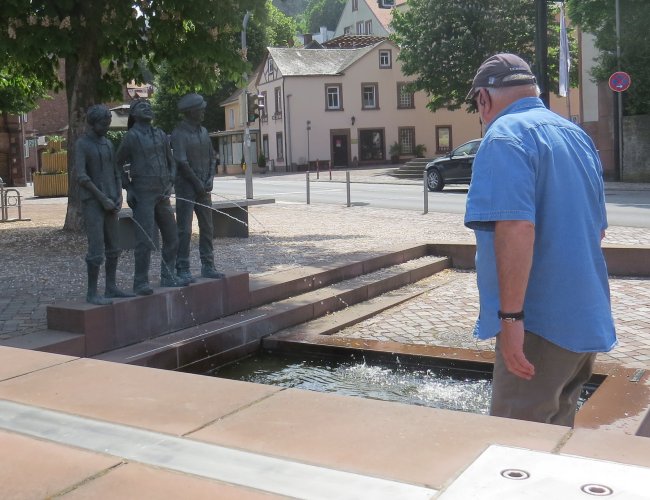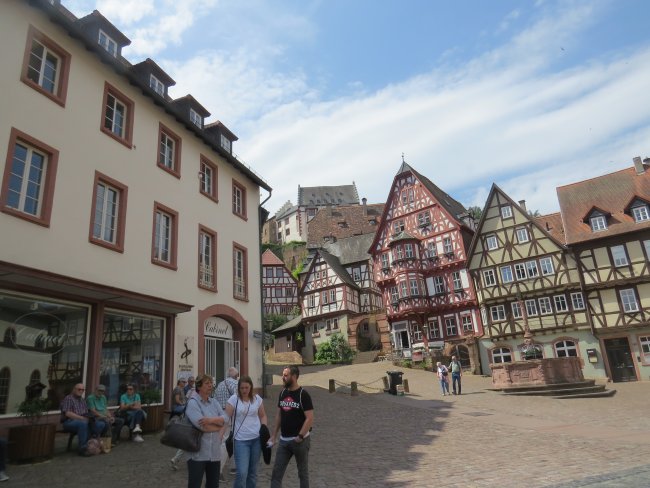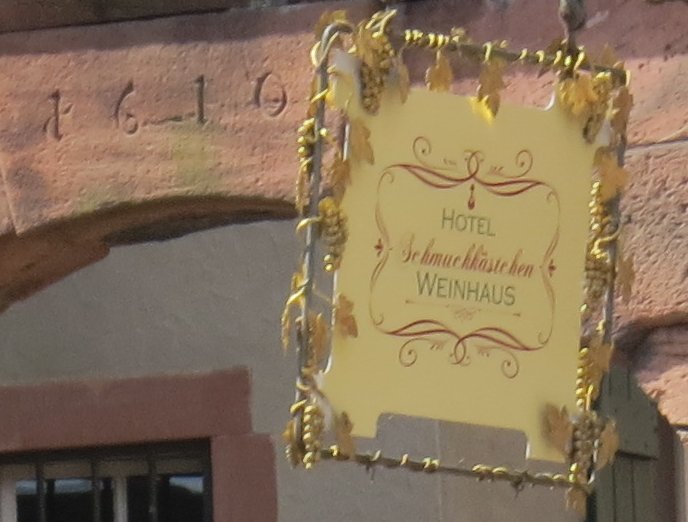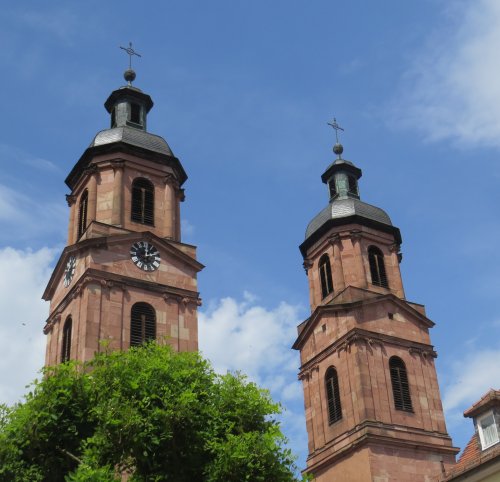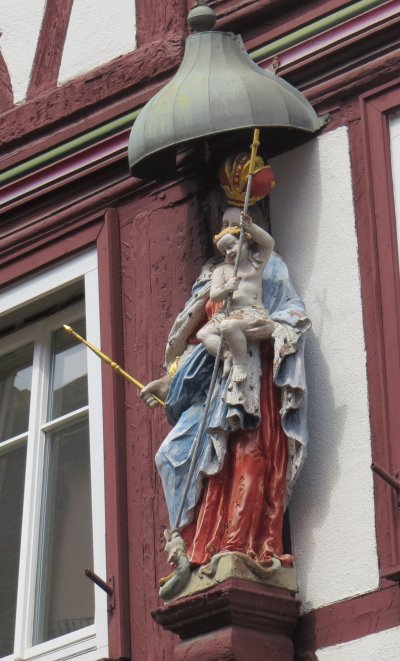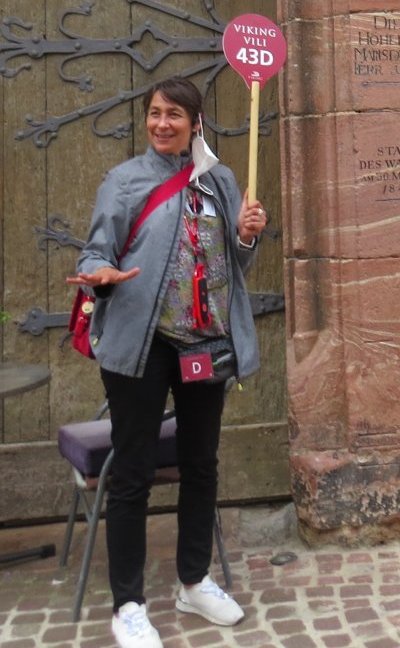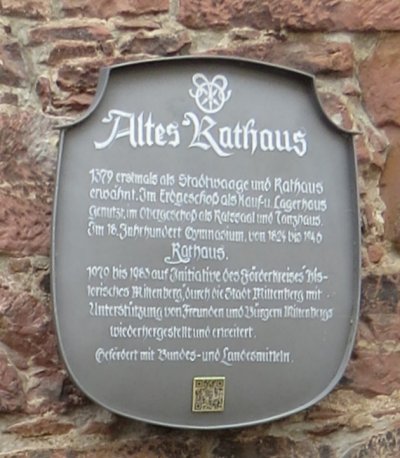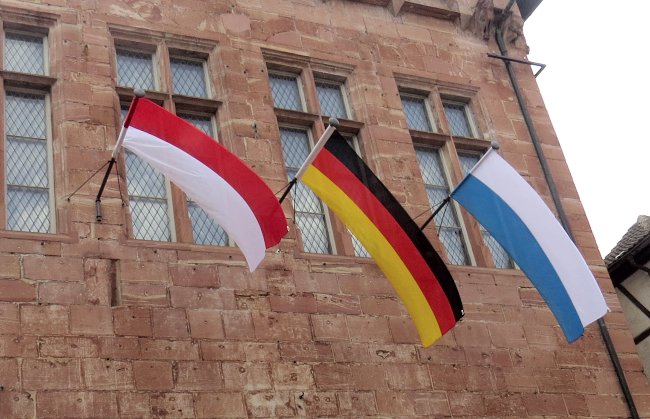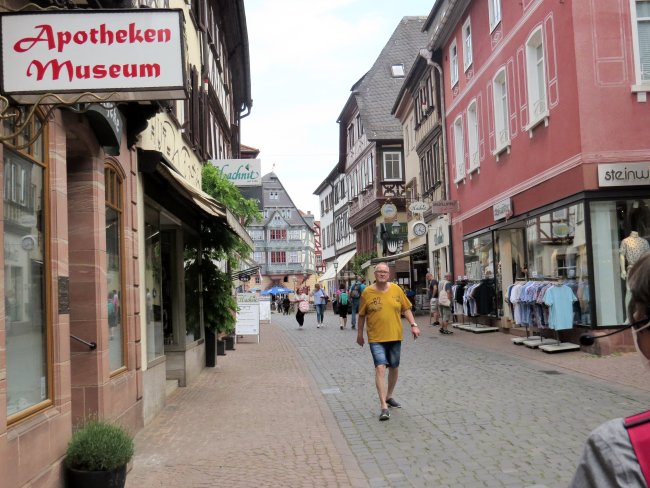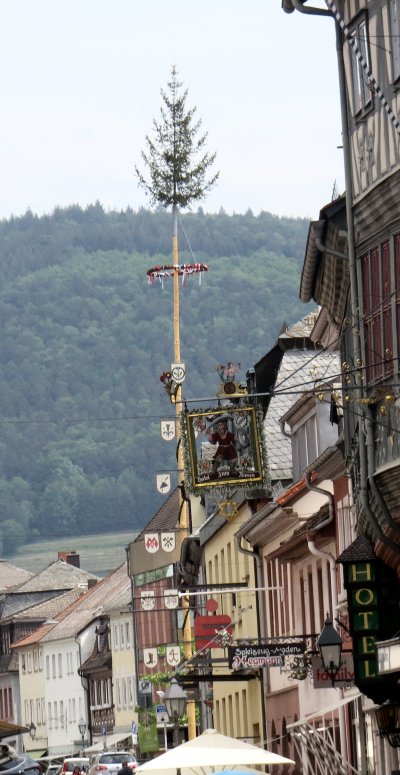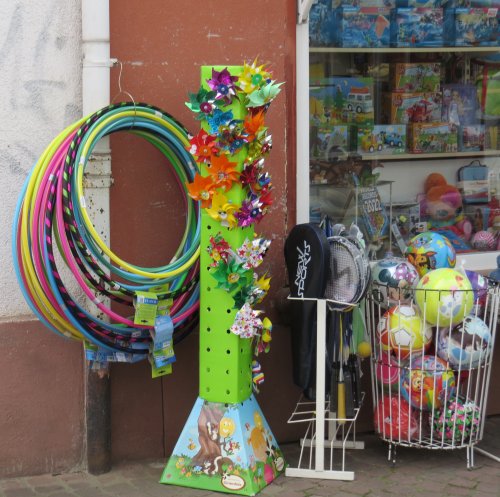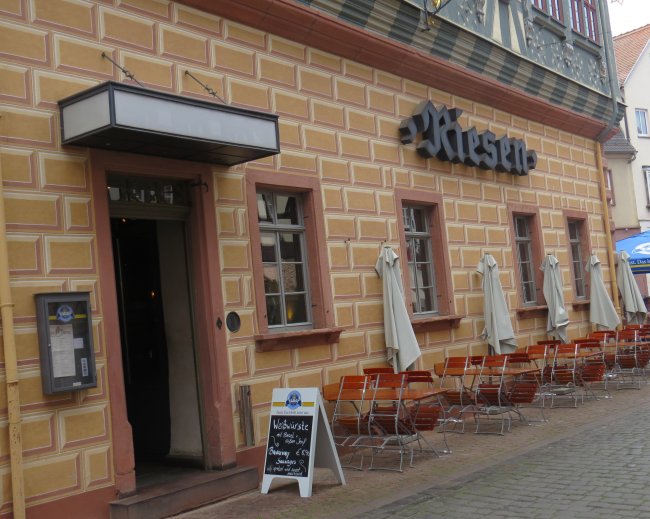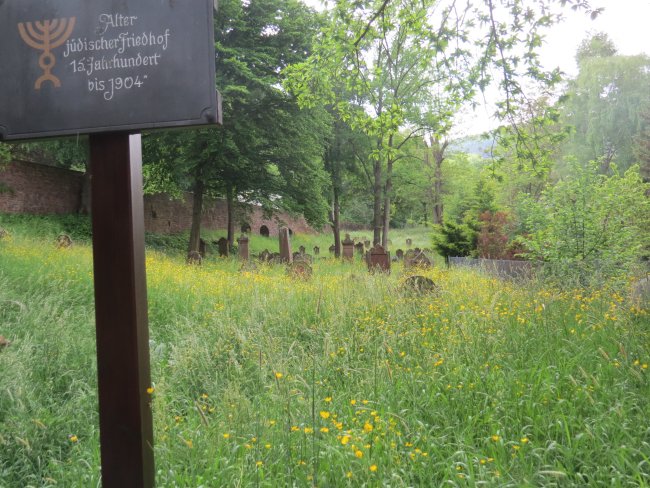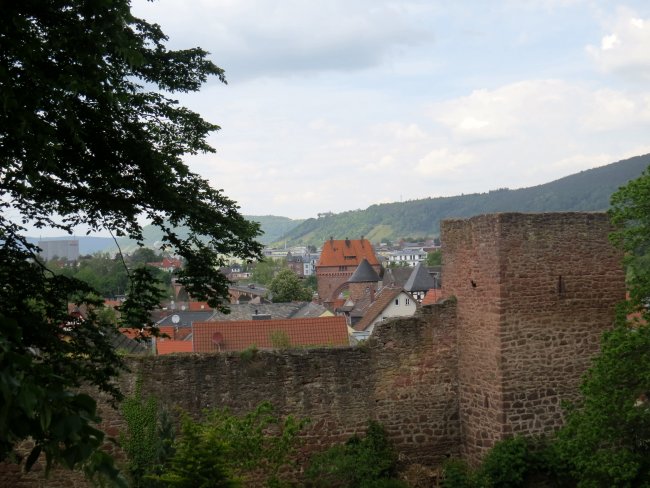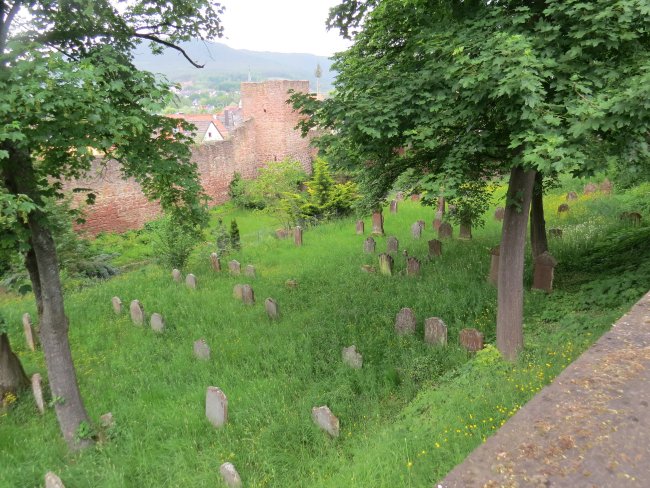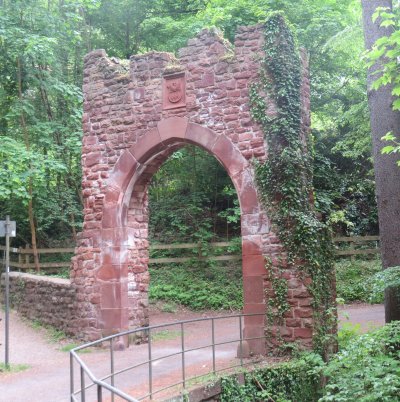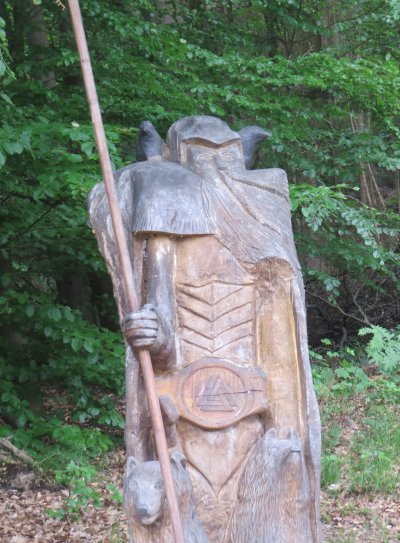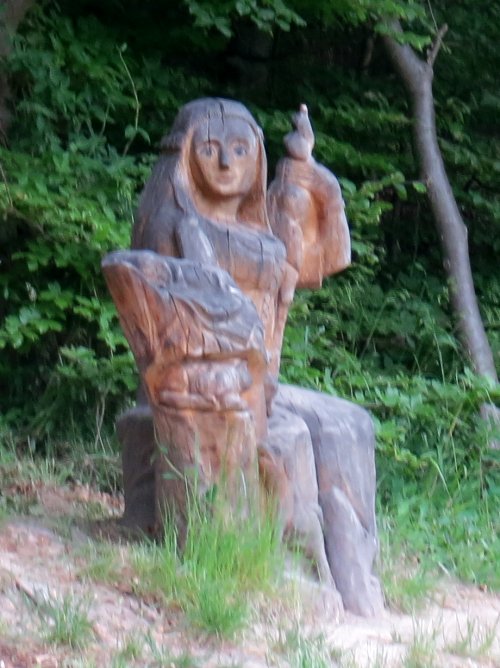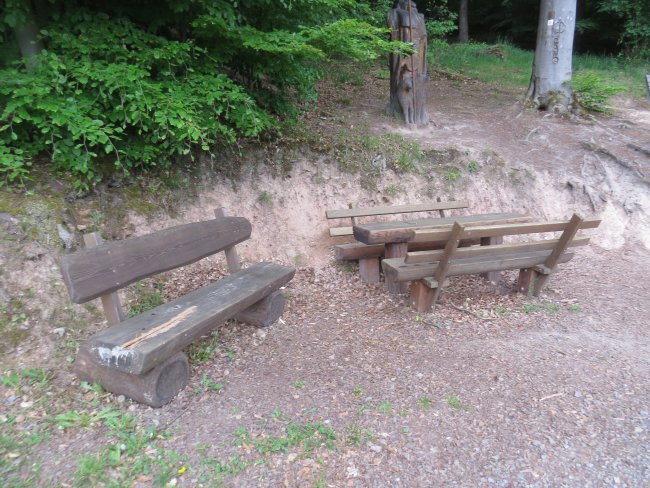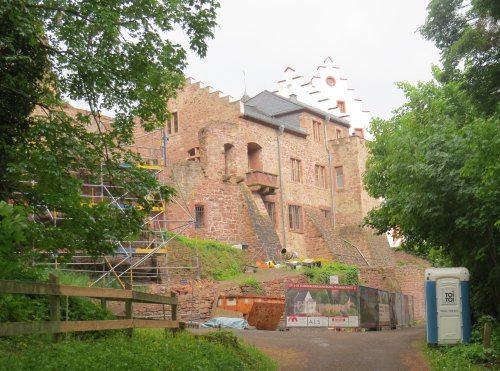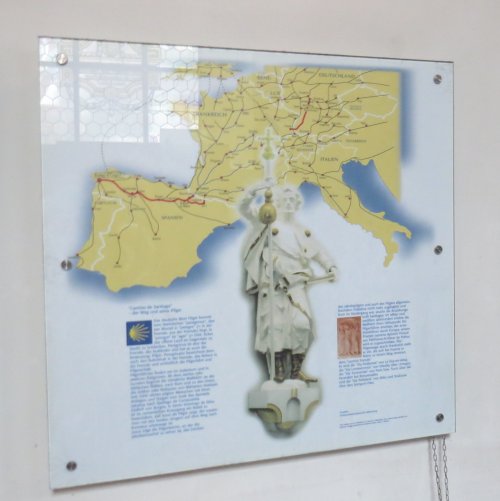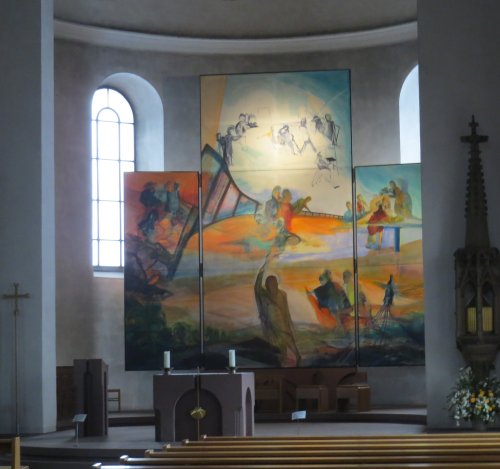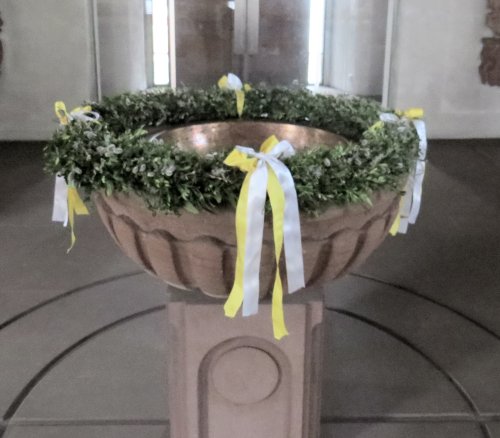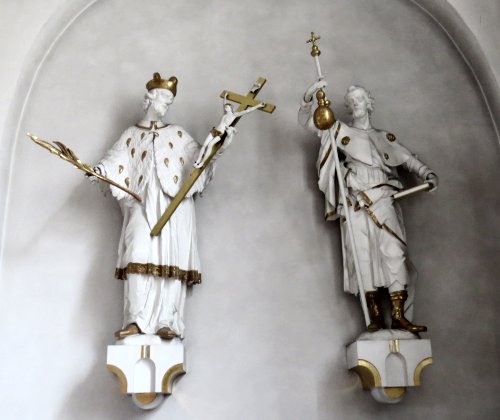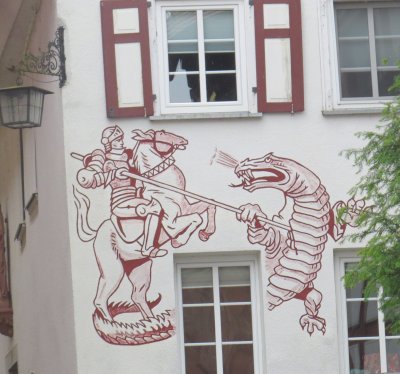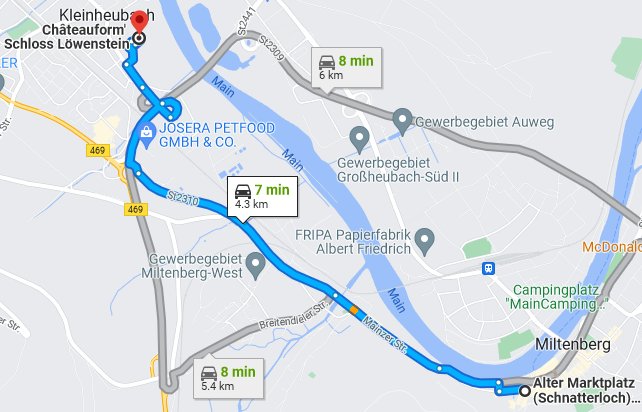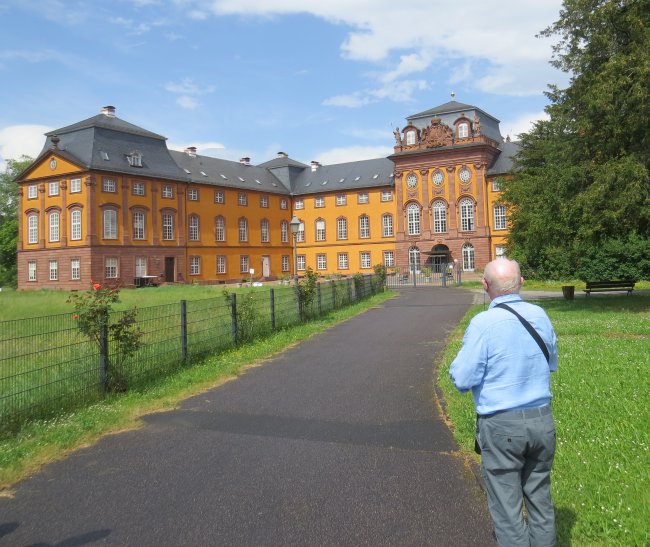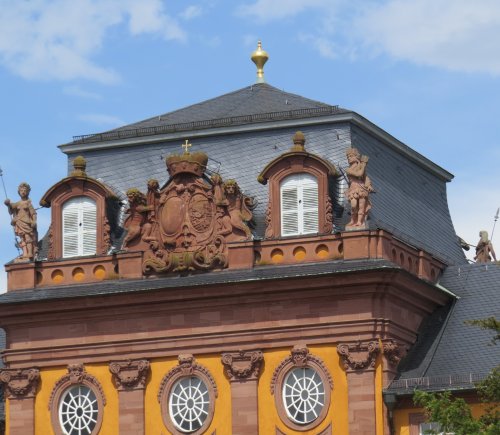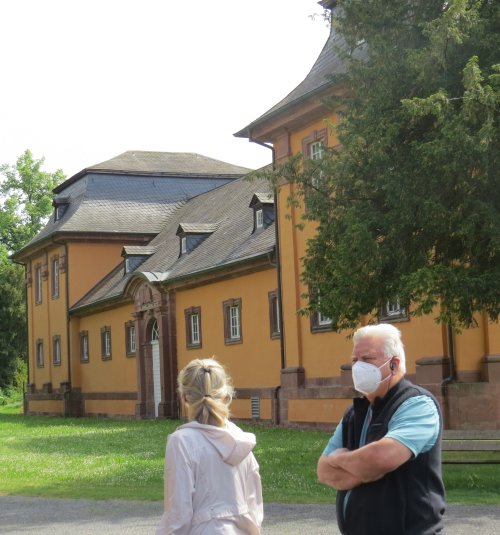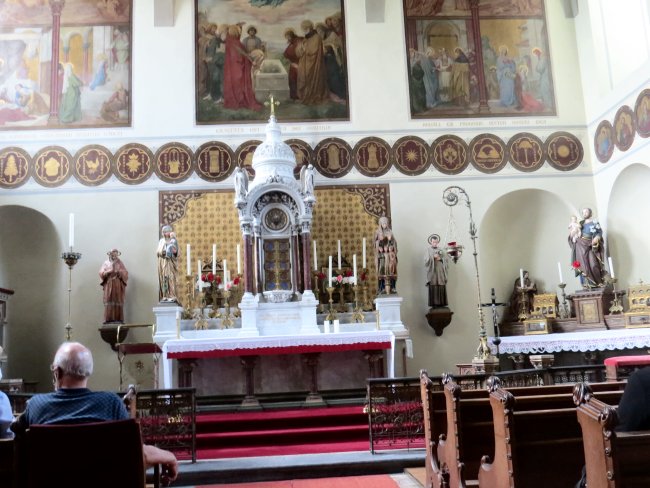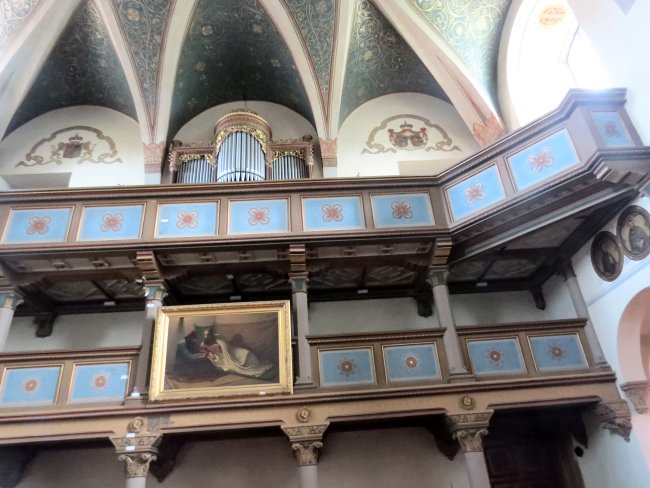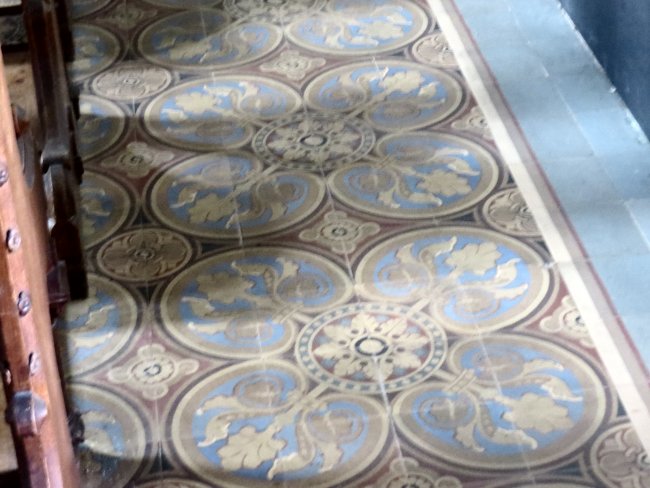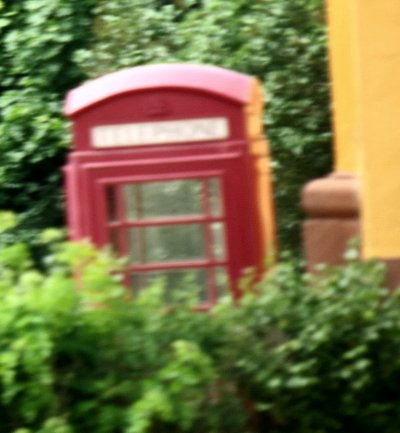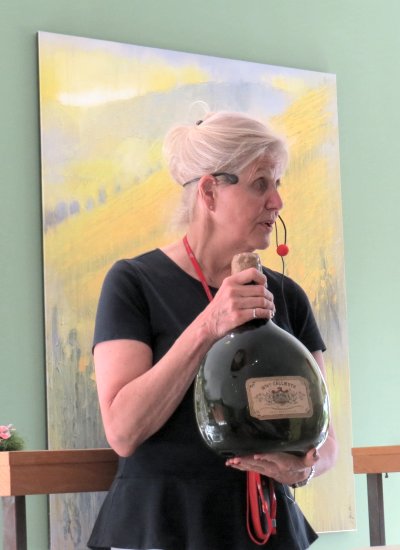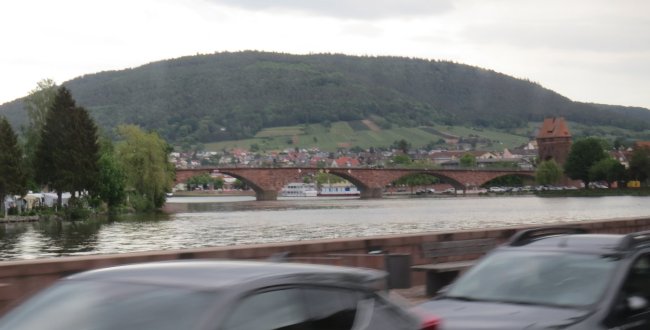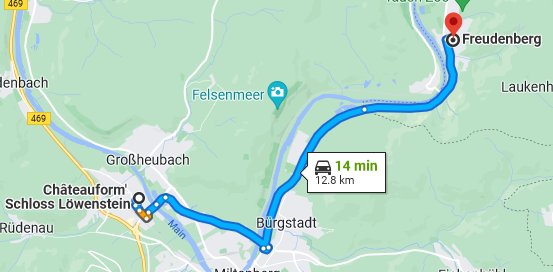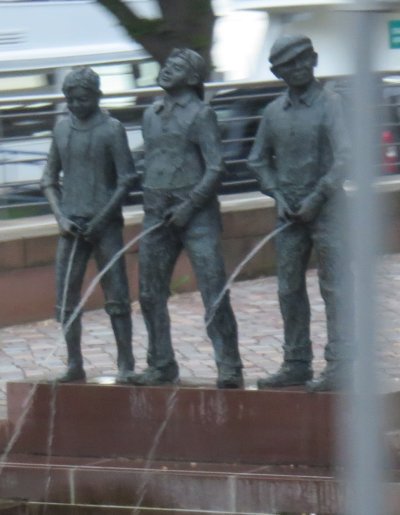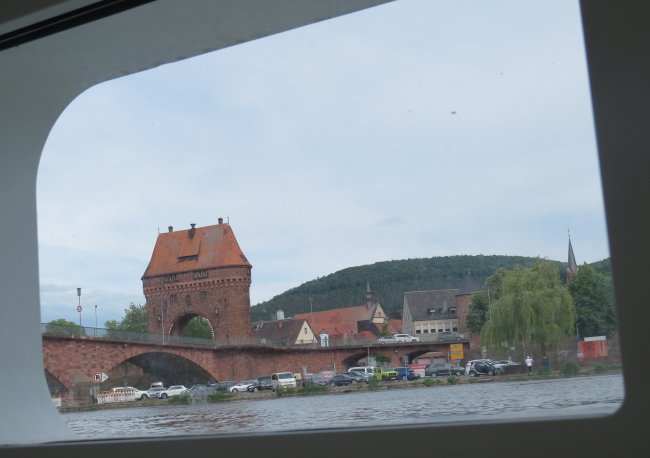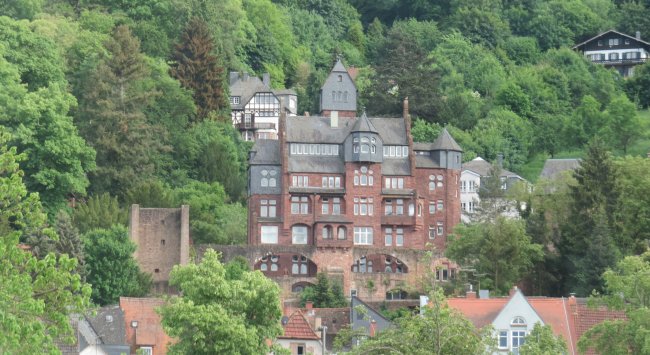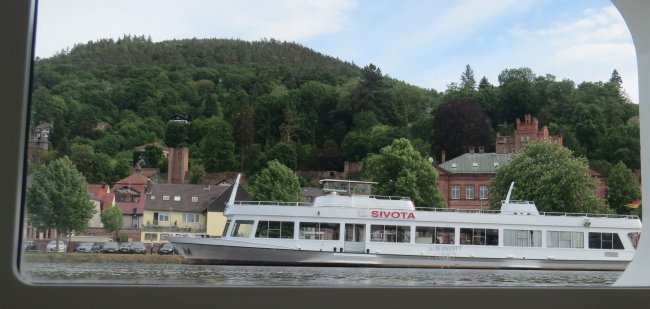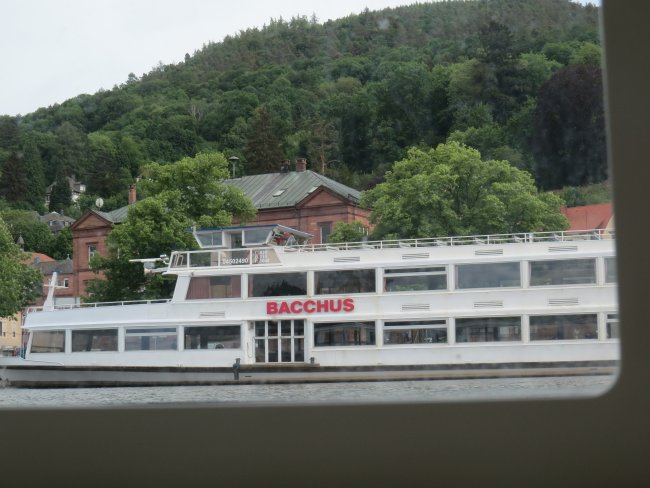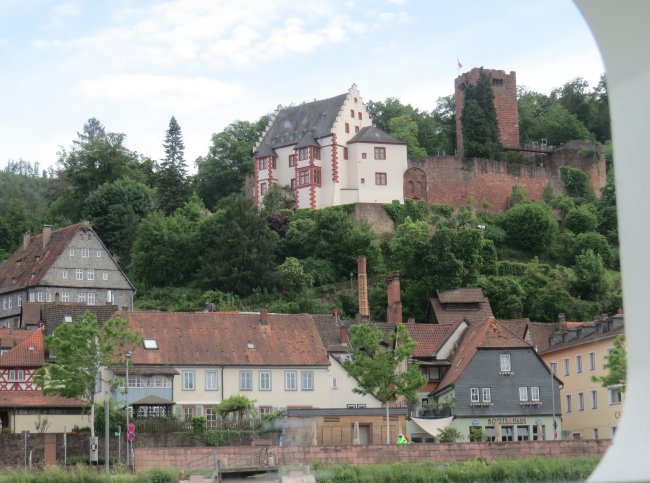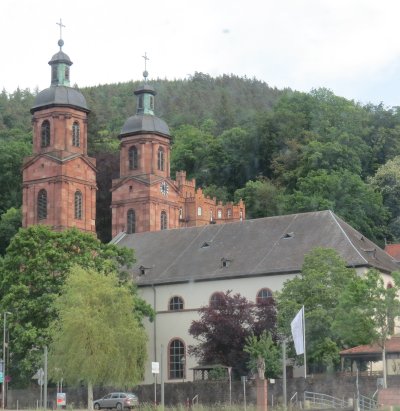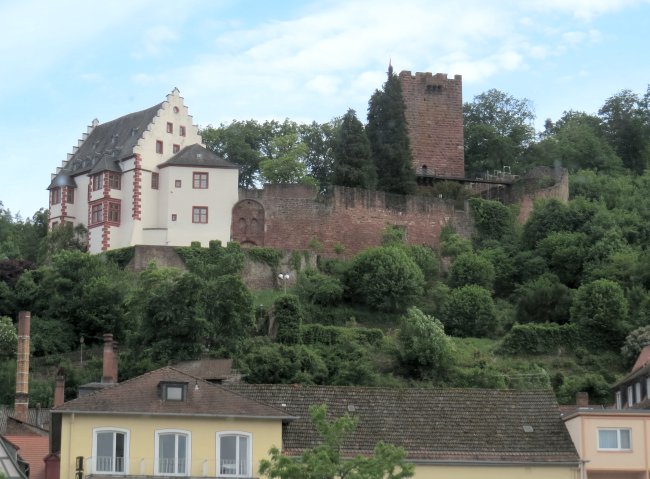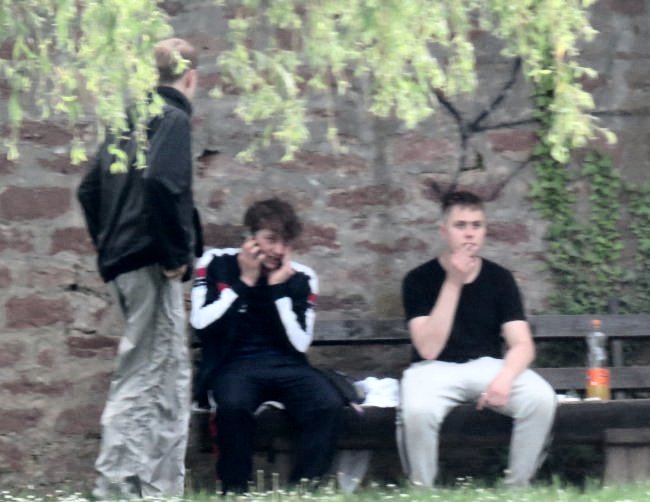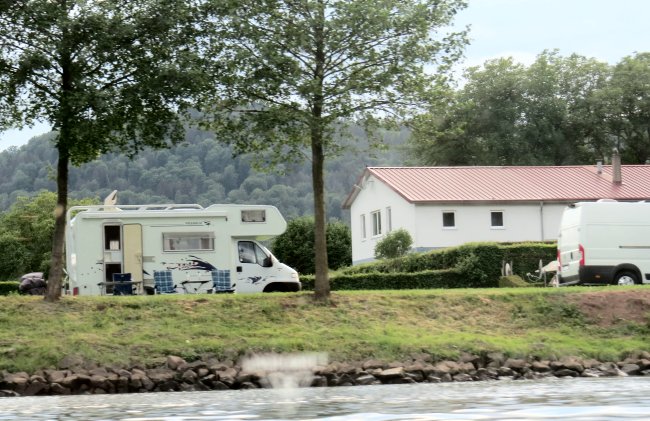Before the excursion : I ate breakfast alone. I was actually the first person to leave the restaurant. The ship was on the Main River, approaching the dock for Wertheim (VARE time). After breakfast I did some more research on the second marriage of Frederick Barbarossa in Würzburg. By the time that I closed down Firefox I was as sure about the order of events as I could be about anything that had happened in the twelfth century.
I sent an email to Sue explaining that I was about to leave the ship, and I would not return until about 11 a.m. her time.
I finished my library book, Bad Monkey by Carl Hiaasen, which I had already renewed online. I rated it ten out of ten. I really enjoyed the protagonist—a police detective with anger-management issues that had resulted in his demotion to inspector of kitchens in restaurants in Key West.
I resolved to find another book worth reading in the ship's library.
I had discovered on my grey slacks a noticeable smudge on the left side near the hip bone. I could not get it out with soap and water. I filled out a form and left it in the laundry bag on the bed.
The weather forecast was not horrible, but it was by far the worst that we had seen on this trip. In his broadcast at 9 a.m., however, Gary Nicholson said that it was a little overcast, but it "was looking like a nice dry day with temperatures going up to 26° Centigrade", which is about 79° Fahrenheit. I don't know where he got his information. The image shown above is a screen shot from weather.com.
I had purchased a ticket for an eight-hour excursion called Modern Aristocracy. The online material said that it as a tour of a very old "fairy tale" castle in the middle of a forest and a tour of parts of a more modern estate. The first was owned by a countess, and the proprietors of the second were members of another title-bearing family of the German nobility. In between lunch would be provided at a restaurant in a town called Miltenberg. We would rejoin the cruise in the town of Freudenberg.
This webpage took me a very long time to create. I had to examine and evaluate the 345 photos that I snapped throughout the day and listen to the thirteen audio recordings that totaled over two hours. In nineteen years of writing travel journals I have never had to deal with so much material for one day.
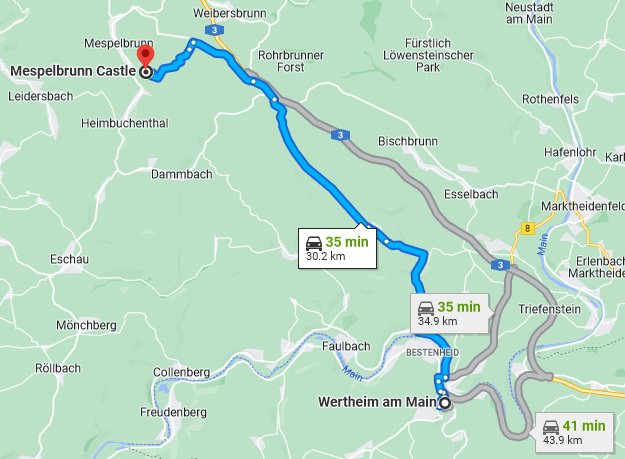
The bus ride to Schloss Mespelbrunn: Don't ask me any questions about Wertheim. At 9:15, a few minutes the Viking Vili docked in Wertheim, our small but mighty group of nine (four couples and myself) disembarked and then boarded the bus that would bring us to the castle. That was the last that we would see of Wertheim.
I doubt that anyone in the group had a clear idea of what awaited us. The description of the excursion had been very vague. I chose it because it sounded like an opportunity to get to know a side of Germany that was seldom encountered on tours. Gary Nicholson had described the two featured stops as "castles". From my research I knew that the second one was actually a hotel that specialized in business conferences with a large wine-making operation on the side. Gary also said that both were owned by the Löwenstein family, but that family actually had nothing to do with Schloss Mespelbrunn, the castle that was our first stop.
Our guide's name was Alexandra Memmel, and the driver's name was Uwe (OO veh). He sported a long ponytail and some ink. They both had driven down from Würzburg on the A3, which took them only thirty minutes. The Viking Vili covered exactly the same distance, but it took all night because it needed to go through several locks.
Within the first minute of the bus journey we passed the spot where the Tauber, which we had seen several times on the road to Rothenburg, emptied into the Main River. Alexandra described the curvaceous path of the Main River as a square and a triangle. She said that Wertheim was in the southeast corner of the square, and Miltenberg was in the southwest. To meet the ship after our excursion Uwe would need to drive the bus east to Freudenberg, which was halfway to Wertheim.
The Main River has long served as the northern boundary of the Spessart Forest (SHPESS art). It was originally known as the Specht Hardt, which meant woodpecker forest. The castle was owned by the Ingelheim family, originally named Echter. After a short tour of the grounds and part of the castle we would be served some smoked trout appetizers with sparkling wine. Then Uwe would drive us to Miltenberg, where we would have a short walking tour and then lunch at a restaurant. At that point we would have driven past the "stronghold" of the family Löwenstein (LOOV en shtine), but they had moved to a small town of Kleinheubach (KLINE hoy bahk). We were scheduled to visit the family's chapel and winery there and then sample three of their wines with some wild boar appetizers. It did not appear that we would be rubbing shoulders with any actual aristocrats.
After a few minutes we departed from the vicinity of the Main River and headed north. To the side were "scattered fruit meadows", which were untended fields that happened to contain a few fruit trees. The silos that we saw belonged to the farmers' cooperatives. The farmers brought their crops there for storage. They were then transported on the river, as are other items such as gasoline. The forest was famous for its oak trees that had been used for furniture. There were also beech, birch, fir, and pine trees. Because the winters for the previous eight years had not been severe, parasites and insects had been moving into the region and damaging the trees and vineyards. The groundwater level was also low.
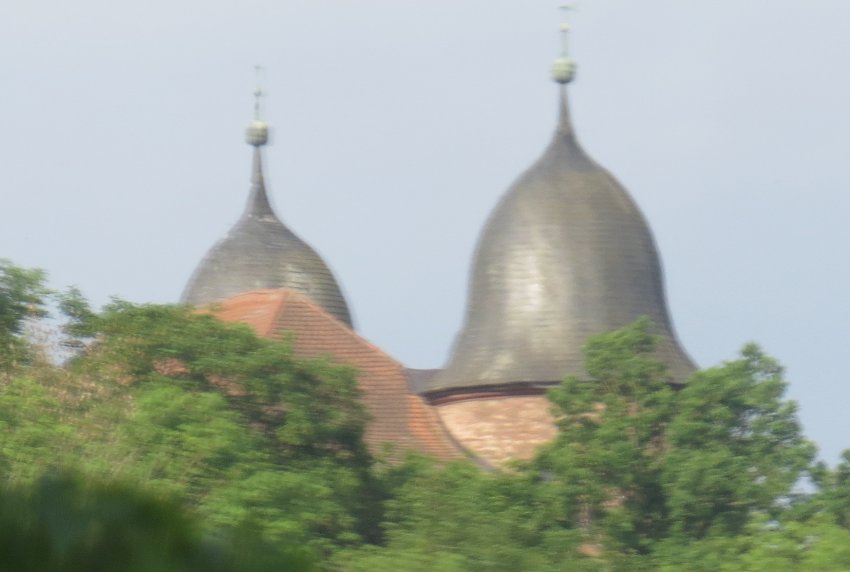
Alexandra brought some spare umbrellas, but I preferred to use my poncho if necessary and keep both hands free for the camera. She said that the presence of the umbrellas usually kept the rain away, but I trusted the poncho in my backpack to perform the same function.
In olden days there were eight times as many trees in the forest. There were few settlements. It was notorious for its wayside robbers. "Foresters" grew vegetables on parts of the forest that they had leased. In the twenty-first century the state of Bavaria owned most of the forest. Other parts were owned by the communities and the old land-owning families like the two that we were visiting. There were also still some foresters.
Wilhelm Hauff wrote two stories about the Spessart Forest that were turned into popular films in the 1960's. Parts of them were shot at the castle. After the release of the films, people began showing up at the castle and asking if they could look around. So, the countess opened up parts of the estate to the public.
The farmers, foresters, and hunters cooperated to keep down the population of wild boars.
Hansel and Gretel and Snow White were set in this region. The "dwarfs" were probably undernourished miners who just looked like shriveled old men.
We drove for a while on the A3, the biggest traffic vein in Germany. It stretches from the Austrian border near Passau to the border with Netherlands south of Cologne, pretty much the same route as the Viking Vili but without all the locks.
We approached the small town of Mespelbrunn (MESH pell brune). The name refers to the well or fountain next to a particular tree that was no longer present.
Alexandra said that she must "disillusion" us. Aristocracy had not existed in Germany since 1918. The nobility lost their privileges after World War I, but they were allowed to keep their titles.
The countess who owned the castle at the time of our visit had a very long name that included both Ingelheim and Echter. The latter family in the 1600's had dwindled down to only one female descendant. She married into the Ingelheim family. Her descendants were allowed to keep both names. Because the current countess had married a baron, she was also considered a baroness. She and the baron spent most of their time in his castle near Cologne, but she generally visited Mespelbrunn once or twice a week.
Our lunch would be at the oldest documented restaurant in Germany. Its name is Zum Riesen, which means The Giant. The meal would be a fresh salad and "Catholic bratwurst" with roasted potato wedges and beer gravy or a fist-sized dumpling (kloß) with cream gravy. For dessert a chocolate cake/tart made without flour would be offered.
We would make a restroom stop, spend an hour or so at the castle, take another restroom break, and then take the bus to Miltenberg for lunch.
The tour of Schloss Mespelbrunn: The group of us walked from the bus to the hedge that separated the owners from commoners. There we got our first view of the castle and the water that surrounded it. Alexandra left us for a bit to make arrangements. It did not appear that anyone else was in attendance on that day.
I confess that I do not remember much about this tour. Alexandra introduced us to Klaus, who was employed by the castle. He was by far the oldest of the guides that we encountered on the cruise. He also admitted that this was the first tour that he had conducted and that his English was not very good.
He talked for a bit about the moat. It definitely had the feel of a fairly large pond, and, in fact, it did contain some fish. My recollection is that the pond was here before the castle was built.
Before we went into the castle, Klaus unlocked the only gate to the garden area. We spent a few minutes walking around. The sky looked threatening, but we did not get wet. Klaus recounted a couple of mildly amusing anecdotes about the family's children playing in the garden.
The "castle" actually consisted of, as I recall, five buildings. I don't remember which building was used for what. We only were allowed into a few rooms.
We spent a few minutes the Knights' Hall. It contained memorabilia and photos. One of the windows contained an insignia that included a red hat with an oversized brim and tassels. I recognized it immediately as a galero, the headgear exclusively worn by cardinals of the Catholic Church. I asked about it. Klaus said that one of the friends of the family was a cardinal.[1]
We then went into the library. We were served little appetizers of bread and trout with a flute of sparkling wine. I don't honestly remember what they tasted like. I do remember that there was a half floor up above us. Its purpose was explained to us, but I have forgotten it.
We were told about the painting with the two bunnies in the foreground. They were meant to reference the ones in the lower left corner of the large drawing hanging on the wall by the stairs.
It rained a few drops while we were at the castle—not enough to merit rain gear.This visit was something of a disappointment. Schloss Mespelbrunn was definitely quaint, but it did not exactly feel like the castle in the middle of a forest that had been described to us.
The place had never been attacked, not even by the U.S. in World War II. It seemed to be a great example of "security by obscurity". In the twentieth century it had been converted into a class C tourist attraction that generated a little cash for a lady living downstream.
My assessment would probably be more positive if the local guide had been better.
Transition to Schloss Löwenstein via Miltenberg: We got back on the bus. Uwe drove us to Miltenberg, where we would walk through the old town and then eat lunch. During the ride Alexandra informed us that this area was popular for people going on holiday because of the clean crisp air. Some local residents rented out rooms to them. The mini-golf court that we passed was allegedly busy on weekends.
Firewood was stacked outside of many houses. Most had central heating; the wood was for fireplaces. It formerly was free to the foresters as part of their compensation from the landowners. That was changed in 2017, but one lady sued to retain her right to free wood and won!
We passed fields that included all kinds of grains. there were also fruit trees. The fruit was preserved in marmalade and juices, but also in schnapps. The most popular was made from the small plums called damson.
Most areas were open. The few fences were designed to keep in animals. Usually there were cornerstones that marked the boundaries. Volunteers regularly checked to assure that the stones had not been moved.
Uwe drove us through Mönchberg, which meant monk's hill. Berg=hill or mountain; Burg=castle. "The burg is on the berg". Each August the town celebrated its documented history of a little over 1200 years with bands, bratwurst, and beer. The town put out benches on the main street, and the people danced on them.
Alexandra distributed maps of Miltenberg, but she said that they would not be needed because there was only one street.[2] One could walk from one end to the other in ten minutes or less. Our journey would be a little longer so that she could point things out to us.
We would have about an hour of free time after lunch. The castle and museum were closed on Mondays. The departure time was set at 3 p.m.
We switched over to the QuietVoxes for the walking tour. We would have time for a restroom break before it began. The town was very photogenic. Despite the threatening weather, the stores placed merchandise out in the street. Unfortunately, I remember almost nothing of what Alexandra told us about the buildings.
I did not take any photos inside the restaurant. Perhaps they asked us not to. I remember enjoying the lunch, but I do not remember the conversation. I was eager to climb up for an aerial view.
I turned right upon leaving the restaurant and walked to the maypole, where I made another right on a street that went up the hill. I was surprised to find that the roads above the city were lined with cars. Evidently employees parked up there. I only saw one other person on the roads or trails.
It drizzled off and on. Only once did I stop under a leafy tree during a short shower.
I knew that the castle would be closed. I was pleasantly surprised to find that three nature trails diverged from it on the hillside above the castle. Each was a circuit. I decided that I had time to hike the one with yellow blazes and still make it back by 3 p.m.
I was delighted to find carved statues along the trail.
As I approached Bismarckweg I considered walking west until I reached the road that the bus had traversed on its way to the old town. I probably could have done it without any problem. However, if I did encounter any significant difficulty, I might be late for our rendezvous. The ship had a tight schedule. Besides, if I hurried, I might get sweaty. Another possibility was significant rain. We still had one aristocratic stop remaining. I would not want to risk giving a countess or princess the vapors.
The only treacherous part of this hike was the descent from the castle back down to the square. The stones on the road were wet and more than a little slippery. My shoes were comfortable, but the tread was not the best.
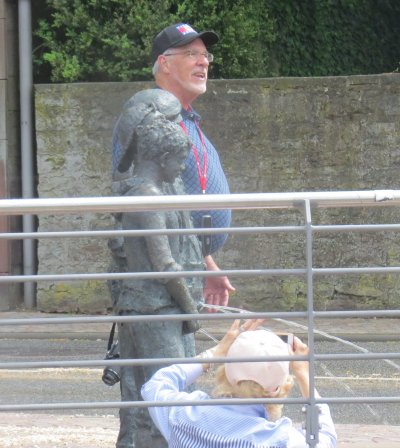
I left the church and looked for a comfortable place to sit that was not wet. The four couples in our group approached the square one at a time. It seemed like it was a very long time before the church bells tolled 3 p.m. Alexandra appeared out of nowhere.
The first thing that Alexandra told us on the bus was that she should not have listened to Uwe, who, like Gary Nicholson, had predicted no rain. She said to put the blame on Mame, right? However, we later learned that there had been a severe storm with thunder and lightning in Würzburg. I suspect that the people who took the other tours or explored Wertheim on their own also might have gotten drenched.
We got a little wet, but I was dry by the time that I reached the bus. Furthermore, the little precipitation that we encountered did not affect my plans to any considerable extent. Five minutes of rest under a tree is well within the bounds of acceptable weather.
Schloss Löwenstein was located in the small town of Kleinheubach, just a few minutes west of Miltenberg. The Löwenstein family was first mentioned in chronicles in 907. In the seventeenth century the family developed a Lutheran branch. The Catholic branch moved away from the original location and set up shop in Kleinheubach.
They built a baroque-style palace—it feels much more like a palace than a castle— that was now leased out as a hotel. The management used the French concept of Châteauform', which meant that they accepted bookings only from groups of a certain size or greater.
We would be allowed to visit the family's private church and its wine cellar, which was formerly a stables that could hold forty horses. It was above ground, of course, but the wine was protected from the heat by the thick sandstone walls.
We passed a factory that produced animal feed for, among others, the cattle that we had seen in the morning.
At the time of our visit Kleinheubach and Miltenberg were administered jointly by a single town government.
The visit to Schloss Löwenstein:: We switched on our QuietVoxes and exited the bus. We had to wait for Alexandra to get the key to the chapel. When she came back I accidentally kept my recorder on in my pocket and, because we were such a small group, I was able to record most of what she said. Unfortunately almost nothing that she said in the church was intelligible, and my memory was at best sketchy.
In most of the palaces in the area the stone was covered with plaster and then decorated. The Löwenstein palace was built from red sandstone, and the exterior had never been altered. This accounted for its unusual orange color.
The heads of the family were called princes,[3] which indicated that they were between a duke and a king. There were only seven electoral princes. None of the Löwenstein family ever achieved that rank. There was also a difference between high and low aristocracy, even though they have the same titles. The Löwenstein family, because they were nobles before 1400, were considered high aristocracy. They were administrators, and at some point they just took over the land that they had been administering. They held a lot of power in the eighteenth century.
The senior princess at the time of our visit, named Anastasia, was the great-great-great granddaughter of Kaiser Wilhelm II, the last Emperor of Germany.
The hotel flew a French flag because the company that ran the hotel was French. They also flew the EU flag and the German flag.
The family had a greenhouse. The fruits produced there were very small. They used them for decorating the table rather than for eating.
The next building was built for messengers, musicians, clerks (she pronounced the word as "clarks" as they do in England), and such. Every room has the same number of windows in order to prevent the servants from fighting.
The horse stable formerly had forty stalls. It was used as a wine cellar in 2022. Before we entered the church Mike Barke spotted a red British phone box in a field near one of the buildings. I later took a photo of it!
We all entered the small church. We only spent about ten minutes inside. Alexandra identified all of the images, but the recording has too much ambient noise. She also talked about the painting of Mary. At the time I did not notice the papal tiara by her feet. If I had, I would certainly have asked which pope was kneeling at her side. I probably will never find out.[4]
Alexandra explained that the family always named the first-born son Karl. There were other traditional names as well. She talked about a family legend concerning a leak in the roof, but I was unable to get the gist of it. There was also something about Nicodemus.
In 1860 Princess Sophie married the King of Portugal in this church.
Alexandra then brought us to the winery where we were introduced to Dorothea, who worked in some capacity for the princess (or whatever her title was) who owned the winery. I was not very interested in the details. The strangest thing was Dorothea's claim that the princess was not as concerned with making money as she was with producing the highest quality wines.We then moved to a room in the hotel in which we were allowed to taste three wines: a Silvaner, which everyone says goes with any kind of food; a Riesling, which is very common in other parts of Germany; and a Pinot Noir, a red wine not usually associated with Germany.
Dorothea was assisted by a young woman named Anna. Anna was a Ukrainian who was a refugee from the Russian invasion of her home country. I would have preferred to hear her story rather than details about wine production.I sat at a table with Mike and Vivienn Barke. The other three couples sat at the other table. We were allowed to sample all three wines, along with some small sandwiches made with salami, bratwurst, and wild boar meat.
They all tasted pretty good to me. Mike was especially fond of the Silvaner. Dorothea had said that they were currently marketing it in China. Mike scoffed at that. He remarked that the Chinese would probably not appreciate the Silvaner.
My clearest memory of Dorothea's presentation was her claim that the vineyard had a microclimate that made it the warmest place in Germany. She said that the temperature sometime reached 0°F or 60°C![5]
We later learned from Alexandra that the winery produced wines that included Riesling grapes from another region, Rheingau. This was very unusual, at least in Germany.
The return trip to the ship:: Alexandra began the narration for the journey to Freudenberg with a story about a writer (I did not record his name) who was asked to choose among literature, wine, and women. He immediately said that he did not need literature. When choosing between wine and women, "it depends on the vintage."
We drove by the Spessart Forest again and then by Miltenberg. We crossed the "old bridge", which actually dated from 1900. Prior to its completion ferrymen transported people across the river, and they had a lot of political influence. During the war the bridge was deliberately damaged so that the allies could not use it.
The campers (RV's) are parked all year; people spend their weekends in them. Swimming is permitted in the river.
A few minutes later we drove through another rain shower. The windshield wipers made a very loud squeak on each passage. As the rain let up Alexandra pointed out the ruins of a castle that had not been destroyed. It was just abandoned. The round tower was used to light fires on the top to warn people of danger. There are now open-air plays performed there. The only way in is via 350 stair steps.
Alexandra was a really superb guide. She was very well prepared and extremely articulate. The other two "expert" guides were not nearly as good.
Viking must have surely taken a financial beating on this excursion, which tied up two people and a bus for an entire day. I feel certain that they paid quite a bit to both of the castles and to the restaurant. There were only nine of us. I wonder how many people needed to sign up in order for them not to cancel it.
After the excursion:
After the ship left Freudenberg we soon sailed past Miltenberg, my third view of the "little jewel" in one day. I was able to take some pretty good sea-level photos from my stateroom to make up for my lackluster efforts on the bus.
I checked my email. There was nothing from Sue.
There was also no sign of the laundry that I had left in the morning.
At some point I recorded Gary Nicholson talking with Chef Roberto about the evening's supper, which would be a buffet of German dishes. It did not make me hungry. There was also a "German Teatime" at 3:30, which our group missed.
At 7:10 I went to supper. The room was already crowded, and most of the people had dressed up. I had changed from my jeans and sneakers to my black slacks and black pseudo-dress shoes, and so I did not feel too out of place. I sat by myself. Later I noticed Mike and Vivienne on the other side of the restaurant.
I ordered the beef broth, which contained a little beef and some other stuff. I also had three kinds of meat with sauerkraut, dumplings, and some kind of unidentified reddish stuff. It was all pretty good. I also had a glass and a half of beer. I passed on dessert.
I also passed on the Sing Along in the lounge. Instead I got some shut-eye.
[1] The cardinals are fairly well documented, and Germany has not had that many over the centuries. I determined that this most likely was one of the members of the von Schönborn family of the eighteenth century, but the dates on the window (1746-1749) are problematic.
[2] Actually, Miltenberg is a town of 9,000 people, very few of whom lived on the street that she referred to. Most of the housing was on the other side of the river. Alexandra's point was that it was almost impossible to get lost, which was quite true if one stayed south of the Main River.
[3] Alexandra provided the German word. It might have been fürst.
[4] It won't be for lack of trying. I found Alexandra's LinkedIn profile and sent her a message with my question. She responded a few days later. She indicated that she did not think that real people were portrayed in the paintings. The pope just symbolized the papacy;
[5] This is less likely than the claim that the three wise men were entombed in the cathedral in Cologne. As of May of 2022 the highest recorded temperature anywhere in Germany was only 103.9. The record for Death Valley, the hottest place on earth, was only 134.


